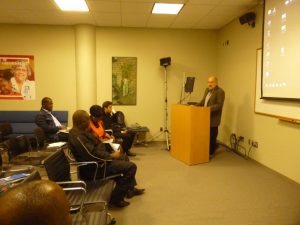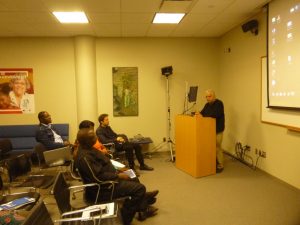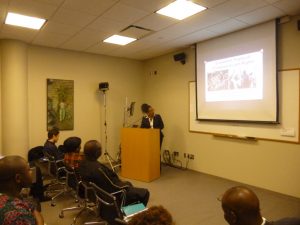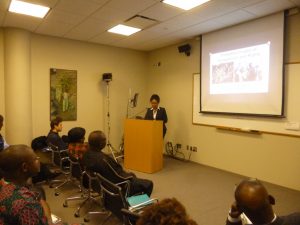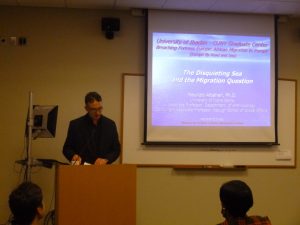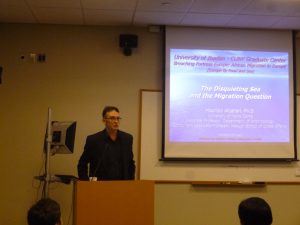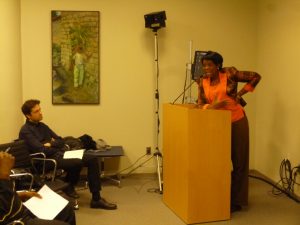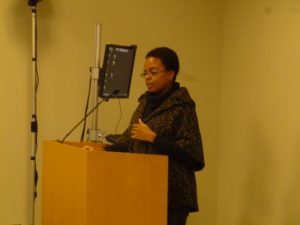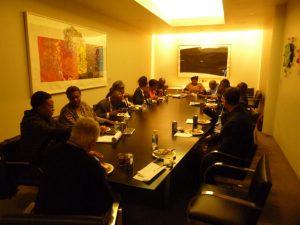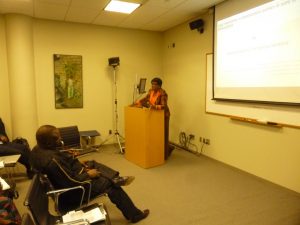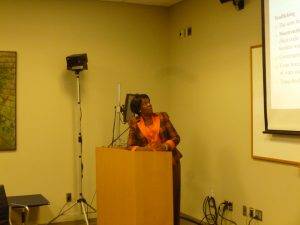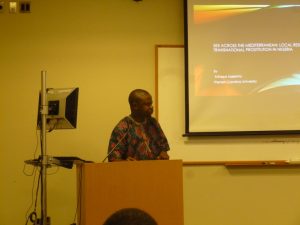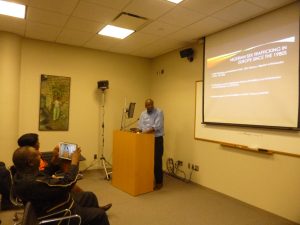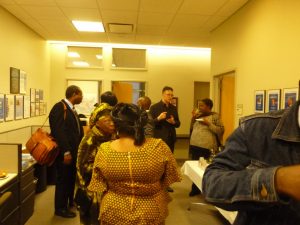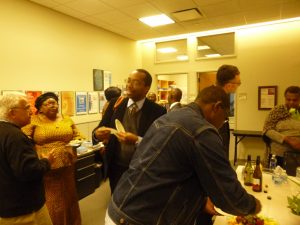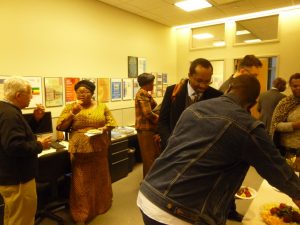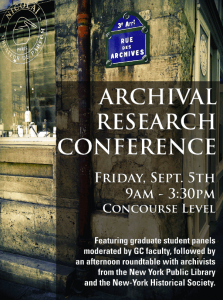Category: Slider
Anthropology and Inequality: Reading Piketty
The issues raised by Piketty are being discussed internationally and the presence of several of the major participants at CUNY or ARC, make this a particularly opportune moment to host a rigorous yearlong examination of Piketty’s work and the arguments surrounding it.
ARC Faculty-Student Seminar 2014-2015
The Graduate Center, CUNY
Room 5318
Fridays 11:45-1:45pm (alternate weeks)
The publication of Thomas Piketty’s Capital in the Twenty First Century sparked a dynamic conversation in the academy and in the public sphere about inequality in the global arena. A Graduate Center event, at which Joseph Stiglitz and Paul Krugman, Nobel laureate economists, discussed Piketty’s presentation was reported in the New York Times. Numerous reviews of Piketty’s argument, from the left and the right have appeared online and in the print media. In this seminar faculty and advanced students from CUNY and elsewhere will read Piketty’s work in detail, focusing on the implications of his work for theorizing the anthropology of inequality. Visiting speakers will present analyses from their perspectives. The issues raised by Piketty are being discussed internationally and the presence of several of the major participants at CUNY or ARC, make this a particularly opportune moment to host a rigorous yearlong examination of Piketty’s work and the arguments surrounding it.
Faculty Coordinators: Ida Susser, Leith Mullings, Jeff Maskovsky
All faculty are welcome. Please email Ida Susser if you are interested in participating or if you would like to recommend students to the seminar: [email protected]
Students will only register for the Spring Semester but will be expected to attend for the year, mostly on alternate Fridays. We encourage second year and upper level doctoral students and as well as returning students who participated in last year’s seminar to attend, but please contact us if you are interested.
| Oct 10 | Introduction: Discussion led by Don Robotham |
| Oct 17 | Part 1: Piketty Discussion led by Doug Henwood |
| Oct 24 | Part 2: Discussion led by Josh Freeman and Michael Blim |
| Oct 31 | Discussion with David Harvey |
| Nov 7 | Discussion with Sanjay Reddy (not confirmed) |
| Nov 14 | Part 3: Discussion led by Jane Schneider and Fran Piven |
| Nov 21 | Discussion with Paul Krugman |
| Dec 12 | Concluding Discussion |
First Annual Graduate Center Archival Research Conference
The Graduate Center’s first Archival Research Conference featured student recipients of one of several different fellowships funded by the Provost’s office. Panels moderated by Graduate Center faculty were followed by an afternoon roundtable featuring New York Public Library and New-York Historical Society archivists discussing the collections they curate.
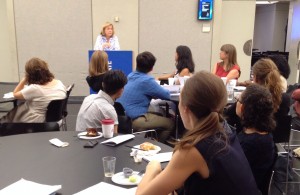 Friday, September 5th, 2014
Friday, September 5th, 2014
CUNY Graduate Center
#GCArchivalResearch
The Graduate Center’s first Archival Research Conference featured student recipients of one of several different fellowships funded by the Provost’s office: the Lost & Found Stipends Program, the Provost’s Digital Innovation Grants, The Advanced Research Collaborative Award for Archival Research in African American and African Diaspora Studies, and The Advanced Research Collaborative Knickerbocker Award for Archival Research in American Studies. Panels moderated by Graduate Center faculty were followed by an afternoon roundtable featuring New York Public Library and New-York Historical Society archivists discussing the collections they curate.
Photos from the conference (via Twitter and Christopher Eng):
In order to showcase the type of research being funded by the Provost’s Office, some of the student presenters have graciously provided their presentations for this conference archive:
- Sean Gerrity (English): Uncovering the Literature and History of US Slave Marronage in the Great Dismal Swamp: An Archival Study at the University of Virginia
- Diana Epelbaum (English): ‘I own I love the vegitable world extremly’: The Gender of Genre and Women’s Natural History Writing, 1688-1808
The full conference schedule and program follows below.
Schedule
9:00-9:20am — Welcoming Remarks
- Duncan Faherty (English and American Studies)
- Provost Louise Lennihan
9:20 – 10:20am — Panel Session I
10:20 – 10:30am — Break
10:30 – 11:30am — Panel Session II
11:30 – 12:15pm — Lunch
12:15 – 1:15pm — Panel Session III
1:15 – 1:30pm — Break
1:30 – 2:30pm — NYC Archivists Roundtable (Elebash Recital Hall)
2:30 – 3:30pm — Reception (Elebash Lobby)
Panel Session I — 9:20-10:20am
C205 — Aesthetics, Politics, and Difference
Chair: Kandice Chuh (English)
- Denisse Andrade* (Earth & Environmental Sciences, Geography)
“The Black Radical Movement and the Poetics and Politics of Land” - Paul Fess* (English)
“Slavery and Anti-slavery: Sound and Text” - Tonya M. Foster* (English)
“Umbra Writers’ Workshop: Archives and Extensions—Tom Dent” - Saisha Grayson* (Art History)
“Cellist, Catalyst, Collaborator: The Work of Charlotte Moorman, 1963-1980″ - Stefanie A Jones* (Theatre)
“Acts of Provocation: Racial Formation and Twenty-First Century U.S. Commercial Theatre”
C203 — Print Culture and Canon Formation in the Early Republic
Chair: William Kelly (English)
- Brian Baaki* (English)
“The Black Criminal in Early American Print Culture” - Courtney Chatellier* (English)
“Archival Research in Early American Literature” - Nora Slonimsky* (History)
“‘The Engine of Free Expression’ [?]: The Political Development of Copyright in the Colonial British Atlantic and Early National United States” - Nicole Zeftel* (Comparative Literature)
“‘The Economics and Poetics’ of the Nineteenth Century Dime Novel”
C197 — Mining Alternative Geographies of Race and Labor
Chair: Herman Bennett (History)
- Hector Agredano* (Earth & Environmental Sciences, Geography)
“Railroads, Railroad Workers and Geographies of the Mexican Revolution of 1910″ - Gordon Randolph Barnes Jr.* (History)
“Imperial Fears: Planter Ideology, Violence, and the Post-Emancipation Experience in the British Empire, 1800-1900″ - Megan Brown* (History)
“Which Integration for Algeria? Eurafrica and the Treaty of Rome” - Jenny LeRoy* (English)
“Capitalizing on the Global South: Eliza McHatton’s Hemispheric Plantation Economy” - Frances Tran* (English)
“Traces of the Coolie: An Archival Encounter”
C201 — Sexuality, Politics, and the Archive
Chair: Alyson Cole (Political Science)
- Meredith Benjamin* (English)
“Engaging Feminism’s Archive” - Elizabeth Decker* (English)
“Recovering Edith Summers Kelley” - Margaret Galvan* (English)
“Watching Out for Dykes in Activist Archives and Special Collections” - Alisa Wade Harrison* (History)
“An Alliance of Ladies: Power, Public Affairs, and Gendered Constructions of the Upper Class in Early National New York City” - Wen Liu* (Psychology)
“Untying the Knot: Archiving the Marriage Equality Movements in Taiwan, China, and the US as Recent History”
Break — 10:20-10:30am
Panel Session II — 10:30-11:30am
C201 — Cultures of Political Economy
Chair: Jessie Daniels (Psychology)
- Flannery Amdahl* (Political Science)
“Big Brother’s Keepers: Liberal Religious Organizations and the Development of the American Welfare State” - Velina Manolova* (English)
“Queer Interventions in Racial Liberalism in the Writings of Lillian Smith, Carson McCullers, James Baldwin, and Lorraine Hansberry, 1944-1970″ - David McCarthy* (Historical Musicology)
“The Appearance of the Comedy LP (1957-1973)” - Adam McMahon* (Political Science)
“President-Led American State Unbuilding 1953-2013″ - Sara Rutkowski* (English)
“The Federal Writers’ Project and its Influence on African American Literature”
C203 — Critical Pedagogies: Rewriting of Knowledge Production
Chair: Steve Brier (Urban Education)
- Nolan Chessman* (English)
“A Pedagogy of Possibility: Adrienne Rich in the Age of Open Admissions” - Diana L. Epelbaum* (English)
“‘I own I love the vegitable world extremly’: The Gender of Genre and Women’s Natural History Writing, 1688-1808″ - Naja Berg Hougaard* (Psychology, Human Development)
“The Past is Not Dead: Resuscitating the Forgotten History of Danish Colonialism in the U.S. Virgin Islands” - Laura Kaplan* (Urban Education)
“The History and Development of P.S. 25″
C197 — Representing Geographies of the Urban and the Rural
Chair: Cindi Katz (Earth & Environmental Sciences)
- Jacob Cohen* (Music)
“Experiences of New England: Urban and Rural in the Music of Chadwick, Ives, Ruggles and Crawford Seeger” - Nicholas Gamso* (English)
“Race, Cities, and American New Wave Documentary of the 1960s and 70s” - Marjorie Gorsline* (Anthropology)
“An Archaeology of Accountability: Race, Power, and Privilege in the Rural Northeast” - Cara Jordan* (Art History)
“Joseph Beuys and Social Sculpture in the United States: Rick Low and Ongoing Residency” - Katherine Uva* (History)
“Dawn of a New Day: New York City Between the Fairs”
C205 — Forum on Digital Initiatives and Fellowships
Chair: Matthew K. Gold (English)
- Amanda Licastro† (English)
“The Writing Studies Tree” - Natascia Boeri† (Sociology)
“Community IT Centers and Organizing Women Workers in Gujarat, India” - Micki Kaufman† (History)
“Quantifying Kissinger”
Lunch — 11:30am-12:15pm
Panel Session III — 12:15-1:15pm
C197 — Diasporic Cultures and Identity Formation
Chair: Sujatha Fernandes (Sociology)
- Anahí Douglas* (English)
“African American Ex-pats and Exiles in Mexico” - Aídah Gil* (History)
“Arthur, Arturo, and the Archive: A History of a Historical Imagination” - Abigail Lapin* (Art History)
“Afro-Brazilian Art, Architecture and the Civil Rights Movement in Brazil, 1960s-80s” - Rocío Gil Martínez de Escobar* (Anthropology)
“Bordering States, Bordering Race: Afro-Indigenous Struggles for Recognition in the Coahuila-Texas Borderland”
C203 — The Performances of Citizenship and National Belonging
Chair: Eric Lott (English)
- Devora Geller* (Musicology)
“Mamele on the Yiddish Stage and Screen” - Sissi Liu* (Theatre)
“Monkey King Performances as Alternative Discourse of Asian Americanness” - Kristin Moriah* (English)
“Dark Stars of the Evening: Performances of African American Citizenship and Identity in Germany, 1890-1930″ - Melissa Phruksachart* (English)
“Cherry Blossoms in Bryant Park: Mediating Asiatic Racialization on Cold War Television” - Hallie Scott* (Art History)
“The Driftwood Village and the Truckin’ University: Experimental Architecture Education on the West Coast, c. 1970″
C205 — The Long Project of Abolition & Black Radical Resistance
Chair: Donald Robotham (Anthropology)
- Laura Bini Carter* (Anthropology)
“Embodied & Inscribed—Gwoka: Guadeloupan Social Movement and UNESCO Immaterial Heritage of France” - Sean Gerrity* (English)
“Uncovering the Literature and History of U.S. Slave Marronage: An Archival Study in Virginia and North Carolina” - Timothy M. Griffiths* (English)
“Other Black Households: The Archives of Queer Black Affective Formations” - Lydia Pelot-Hobbs* (Earth & Environmental Sciences, Geography)
“The Consolidation of the Louisiana Carceral State, 1970-1995″ - Wendy Tronrud* (English)
“Buried Alive: Researching William Walker and Thomas Gaines”
C201 — Lost and Found
Chair: Ammiel Alcalay (English)
- Lauren Bailey‡ (English)
- Philip Griffith‡ (French)
- Gabrielle Kappes‡ (English)
- Kai Krienke‡ (Comparative Literature)
- Megan Paslawski‡ (English)
- Alex Wermer-Colan‡ (English)
Break — 1:15-1:30pm
NYC Archivists Roundtable — 1:30-2:30pm
Elebash Recital Hall
Welcoming Remarks by President Chase Robinson
Chair: Polly Thistlethwaite, Chief Librarian CUNY Graduate Center
Panelists:
- Steven G. Fullwood – Assistant Curator, Manuscripts, Archives and Rare Books Division, Schomburg Center for Research in Black Culture, New York Public Library
- Bob Kosovsky – Curator, Rare Books and Manuscripts, Music Division, The New York Public Library for the Performing Arts
- Marilyn Satin Kushner – Curator and Head, Department of Prints, Photographs, and Architectural Collections New-York Historical Society
- Thomas Lannon – Assistant Curator, The New York Public Library Manuscripts and Archives Division
- Edward O’Reilly – Curator and Head, Manuscript Department, Patricia D. Klingenstein Library, New-York Historical Society
- Mary F. Yearwood – Curator, Photographs and Prints Division, Schomburg Center for Research in Black Culture, New York Public Library
Reception — 2:30-3:30pm
Elebash Lobby
* ARC Archival Research Grant Recipients
Names marked with an asterisk (*) received research funding through the ARC Knickerbocker Archival Research Grant in American Studies or the ARC Archival Research Grant in African American and African Diaspora Studies.
Additional grant recipients not listed above:
- Vanessa Burrows (History)
“The Medicalization of Stress: Hans Selye and the Transformation of the Postwar Medical Marketplace” - Omar Ramadan-Santiago (Anthropology)
Performing the Third Race: Rastafari and the Racial Imagination in Puerto Rico
† Provost’s Digital Innovation Grant Recipients
Names marked with a dagger (†) received funding through the Provost’s Digital Innovations Grant Program for the 2013-14 academic year.
‡Lost & Found Stipend Recipients
Names marked with a double dagger (‡) received funding through the Center for the Humanities Lost & Found Stipend Program for the 2013-14 year.
Mojúbàolú Olúfúnké Okome Discusses Abduction of Girls by Boko Haram, Nigeria on PBS Newshour
On 5 May 2014, ARC Distinguished CUNY Fellow Mojúbàolú Olúfúnké Okome appeared on PBS Newshour to discuss the abduction of hundreds of girls by Boko Haram, in Nigeria.
Income Inequality LIS Book Launch
Income Inequality: Economic Disparities and the Middle Class in Affluent Countries, book launch. Panel with editors Janet Gornick, Director of LIS and professor at The Graduate Center, and Markus Jäntti, Research Director of LIS and professor at Stockholm University, and moderated by Branko Milanovic, expert on global inequality at The World Bank.
Contributing authors present their chapters: Arthur Alderson of Indiana University, Bloomington; Bruce Bradbury of University of New South Wales; Louis Chauvel of the University of Luxembourg; Nancy Folbre of the University of Massachusetts, Amherst; Vincent Mahler of Loyola University, Chicago; Stefán Ólafsson of University of Iceland; and Reeve Vanneman of the University of Maryland.
BA@20 Roundtable
Twenty years after the publication of Paul Gilroy’s The Black Atlantic: Modernity and Double Consciousness (1993), scholarship no longer simply posits the relationship between blackness and modernity as an irreconcilable problem. Though Gilroy posited The Black Atlantic as a ‘heuristic’ work, his ideas engendered debates in history, anthropology, and literary studies as well as political thought and philosophy—areas once perceived as the exclusive domain of an organic and hermetically sealed Western tradition. The Black Atlantic @ Twenty symposium (BA@20) aims to explore how Gilroy’s insistence that blackness figures as a constitutive element of modernity has effected a lasting transformation in knowledge production.
Taksim Is/Is Not Tahrir: Comparative Frameworks in Managing Protest
by Danya Al-Saleh and Mohammed Rafi Arefin.
Danya Al-Saleh is an Anthropology Ph.D student at the Graduate Center, CUNY.
Published July 27, 2013 in Jadaliyya.
Taksim is Tahrir. Taksim is not Tahrir. As the Gezi-Taksim protests began to escalate in early June, these comparative and contrasting statements were proposed in the media and amongst activists. Responding to this debate, the Adalet ve Kalkınma Partisi (AKP) has continued to address the question of Taksim’s relationship to Tahrir. On 12 June, Prime Minister of European Union Affairs and Chief Negotiator Egeman Bağis quickly dismissed the question of Tahrir’s comparison with Taksim: “The situation in Turkey is not similar to the ones in Egypt, Libya, and Tunisia. If Turkish electors are not happy with our practices they will show this in the next elections.” The distancing of Taksim from Tahrir was then reversed as the Turkish government began to assert itself in Egypt’s coup/revolution debate. In condemning the 3 July military intervention, Prime Minister Recep Tayyip Erdoğan’s avowal—“my president in Egypt is Morsi”—was also a stand in defense of himself.
Bağis’ comments assert that Taksim “is not” Tahrir, whereas Erdoğan’s aggressive defense of Morsi suggests that Taksim “is” Tahrir. Each of these “is” and “is not” statements is attached to critical stakes for the Turkish government. In the case of “is not,” the statement served to limit the scope and potential capacity of protest in both Gezi Park and Tahrir. The “is” statement, on the other hand, emerging through the AKP’s determination to define Egypt’s military intervention as a coup, represents a fearful response to protest movements in Turkey and legitimizes hegemonic visions of liberal democracy and stability.
Although the stakes outlined above speak to the AKP’s strategic interests, these definitive “is” and “is not” comparative statements more generally parse complex movements into manageable units of analysis. These analytical units, once rendered comparable, serve to limit the capacity and scope of protest, not only in Gezi Park and Tahrir, but elsewhere. The comparative framework imposed through these statements is bound up in motives and forces emerging out of the Cold War that continue to appropriate protest through technocratic and managerial logics. These logics, purported to systematically regulate democracy, economic stability, and electoral politics, fail to address the demands of mobilizing movements on the ground.
Rather than promoting a particular vision of comparison or complicating the decisive “is” and “is not” debate, we situate our contribution in between the statements “Taksim is Tahrir” and “Taksim is not Tahrir.”
Cold War Logics and the Arab Spring
Rather than discretely assessing the statements “Taksim is Tahrir” and “Taksim is not Tahrir” through immediate events, it is necessary to embed these debates in recent histories of protest and their representation by the media. The managerial logics that were used to represent what came to be called the Arab Spring, having lent a predictable and comfortable trajectory to the uprisings of 2011-2012, are currently being mobilized to order geopolitical ruptures in Turkey and Egypt.
Due to ossified ideas about the Middle East, the protests in Tunisia, Libya, Egypt, Bahrain, and Syria contained an element of unpredictability and surprise to Western observers. The term “Arab Spring” gained currency across the media because it organized disruptive geo-political ruptures, deemed both shocking and potentially terrifying to Western audiences, within a comforting historical narrative rooted in Cold War logics. This narrative is comforting because it emerged from a war that the United States won—ideologically, at least. This victory was best expressed by two texts. With the publication of Francis Fukuyama’s The End of History and the Last Man, American liberal democracy and capitalism became the master narratives by which the rest of the world was ordered. Four years later, Samuel Huntington’s The Clash of Civilizations identified the fault lines where threats to the Last Man would emerge between self-contained “civilizations,” and prescribed a method to manage such clashes.
In 2011, the desire to compare Tunisia and Egypt to Libya, and Bahrain with Syria, worked to mold chaotic and therefore uncontrollable ruptures into a predictable unit of analysis. The naming of the “Arab Spring” was thus a project of homogenization, naturalization, and management. Rhetorically tied to the seasons, Arab Spring assumes a temporality that naturalizes the universalization of Western liberal democratic models. The Arab Spring is seen to be preceded by various Cold War springs (the Prague Spring, the Croatian Spring, and the Beijing Spring); in the West, these springs identified the political and economic “awakening” of Soviet and Maoist regimes to Western liberal democracy. While the framing of resistance, uprising, and protest in terms of seasonal change connotes progressive rejuvenation, the label brings to the forefront the establishment of liberal democratic governing structures through technocratic reform. Evacuated of their substantive demands, oriented around human repression and social justice, these sequences of Cold War “springs” indicated the inevitable thawing of the Cold War, broadly associated with the decentralization of the economy, self-determination, and various political promises of freedom and democracy.
In the case of Egypt, the term “Arab Spring” did not merely lend a comforting order to the events by analogizing disruptive revolution with the natural coming and going of the seasons. The notion of an Arab Spring has also managed the past events leading up to the “thawing” of liberal democracy: Through years of geopolitical maneuvering, development aid, and IMF restructuring policies, foreign governments such as the US and Britain have supported the Mubarak and Morsi regimes. Despite the historic relationship between the Mubarak regime, the West, and international financial institutions, the label “Spring” attributes the uprising to the absence of free and fair elections and the dismantling of a singular totalitarian despot. Additionally, in this historically post-Cold War event (which is nevertheless managed through a Cold War framework), the concern shifts from the human condition to questions of threats against Western hegemony (for instance, the Western media’s immediate concern about what January 2011 meant for Israeli security.)
Taksim IS NOT Tahrir
As the Gezi-Taksim protests escalated, the movement’s comparison with the Arab Spring became a subject of debate within the media. Articles were given titles that either alluded to the relationship between Taksim and the Arab Spring (such as “The Right to the City Movement and the Turkish Summer”) or explicitly addressed the Tahrir comparison (“Taksim is Not (Yet) Tahrir,” “Taksim Square is not Tahrir Square,” and “From Tahrir to Taksim: Are the Taksim Square Protests Turkey’s Arab Spring?”) However, amongst these scholars, journalists, and government spokespeople (spanning from the AKP to Russian diplomats), the predominant verdict was “Taksim IS NOT Tahrir.”
The “Taksim is Tahrir” statement was consistently dismissed by AKP officials based on the recognition that Turkey has already had its so-called “Spring”: liberal democracy prevails in Turkey, and if protestors want to enact change, they are free to do so at the polls like Americans and Europeans (Yel and Nas). The realization of free and fair elections in Turkey is extended to counter the Tahrir comparison: Erdoğan is a legitimate office-holder, it is argued, and unlike the former dictators of Egypt and Libya, he responded to protests as any politician would—with tear gas, batons, and pepper spray—as opposed to such undemocratic spectacles as men on camels and bullets.
The rejection of the “is” statement is also oriented around numbers: disparate death tolls and women’s rights abuses. The disparate numbers in deaths and sexual assaults in Tahrir and Taksim are pointed out to extend claims about the legitimacy of the Turkish government’s reaction to protest. Dashiell Bennet explained in the Atlantic: “To be sure, there has been a heavy hand and some abuse in Turkey, but the most shocking image (a woman being pepper-sprayed in the face) is no more harsh than what Americans saw at the height of the Occupy Wall Street (OWS) movement.” Numbers also serve to write off the violence occurring in Taksim-Gezi itself. Dismissing the comparison along these lines, Mohammed Khalid Alyahya begins another “is not” editorial by proclaiming his amusement with the Taksim protests: “I thoroughly enjoyed the pictures of the whirling dervish in a gas mask; he was unequivocally iconic. The pictures of the colorfully dressed yogis at Gezi Park were equally intriguing.”
Associated with popular concerns specific to late democratic societies, such as the environment, protest in Gezi Park is thus dismissed through these sorts of Tahrir comparisons. Differentiated from the larger, more immediate concerns of Egyptian protesters, such as free elections, issues such as urban green space are deemed irrelevant to those living under a dictatorship. The humor employed by protesters in Taksim Square—which is associated by these analysts with secularists, leftists, LGBT activists, and the Western-educated upper middle class elite—is also used to distinguish Taksim from Tahrir. Such comparisons do not merely render Taksim as the frivolous pursuit of playful fringe groups; the “is not” statement simultaneously erases the diverse claims and mobilizations in Egypt. In 2011, the protesters in Tahrir—themselves diverse in gender, class, sexual orientation, religion, and age—also drew on humor and were concerned with broad issues spanning the environment, education, security, and even pest control.
Returning to the organizing logics of “Arab Spring,” it is no surprise that the Tahrir/Taksim comparison was heatedly contested. Opinion pieces that dismiss the “is” statement are framed by the Arab Spring’s temporal framework, which translates protest as the inevitable universalization of liberal democratic institutions. This temporal understanding of liberal democratic progress neatly categorizes the world into free, unfree, and partially free nation-states. In a country that is already considered “free,” like Turkey, protest and uprising make no legitimate sense. Moments of uprising in “mature” democratic countries (like Occupy Wall Street) are considered internal problems that should neither pose a threat to established political and economic institutions nor require foreign intervention. Instead, these protests are attributed to technocratic mismanagement.
Through this temporal framework of free, unfree, and partially free, struggles over the human condition in Turkey are minimized; everything, from the environment to the economy, is considered a technocratic issue to be handled by apolitical experts. In this regard, as Mina Akrami writes, Erdoğan’ s effective “steering” of the economy enables the “Tahrir is Taksim” statement to be dismissed: “Since Erdoğan took office in 2002, the GDP growth has averaged over five percent…the Turkish economy grew by 8.5 percent in 2011 and is expected to continue growing.” In a “free” country, economic issues are understood to be resolved technocratically; those elected officials who sustain its growth through effective management cannot logically be the subject of popular protest.
Accordingly, determined as it is to join the European Union, the Turkish government must dismiss the Tahrir comparison: Turkey has already thawed and should not be confused with those Eastern countries that are still undergoing their successive Springs, requiring foreign mediation and intervention. Bağis claimed: “the Turkish Spring occurred long ago, when the AK Party revolutionized the country after winning a majority of seats in parliament in 2002” (Yel and Nas). With the temporal register of “Arab Spring” in mind, it makes analytical and political sense that the AKP prefers Occupy Wall Street parallels to the Tahrir comparison. By contrasting Taksim with Tahrir and comparing it instead with OWS, protesters’ claims, if acknowledged at all by the government, are considered manageable through tedious technocratic reform, rather than by the transformation of existing governing structures or the system’s overhaul.
Taksim IS Tahrir
After Egypt’s 3 July military intervention, journalists and academics immediately began addressing the event’s implications for Turkey, publishing policy recommendations (“Egypt Lessons for Turkey,” “Turkish Concerns Over Egypt’s Coup Derailment”) and comparative analyses (with titles such as “The Gezi Park Protests: Is Turkey Becoming Egypt?” and “Turkish Perceptions of the Egyptian Coup”). In light of 30 June, there continue to be critical stakes orienting the decisive statements that Taksim “is” or “is not” Tahrir, for both the AKP leadership and Egypt’s interim government. The struggle to assess the 3 July military intervention—as an illegal coup or as a people’s revolution—has taken place, in part, through this Taksim/Tahrir comparative framework. As we noted earlier, the Taksim/Tahrir framework pursues an analysis that categorizes events according to the universal expansion of liberal democracy. However, after 3 July, this comparative analysis has also emphasized the threat to democratic elections by military rule, subsequently neglecting the varied struggles over social and economic justice in Egypt and Turkey.
The Turkish government, asserting itself in the coup/revolution debate, immediately condemned Egypt’s 3 July military intervention and launched a campaign criticizing the West for its silence. On 14 July, Erdoğan declared, “Currently, my president in Egypt is Morsi because he was elected by the people.” A few days later, Erdoğan rejected a telephone call requested by Mohamed El-Baradei, Egypt’s acting Vice President. In remarks carried on the website of CNN-Türk, Erdoğan asserted that he would refuse dialogue with all interim leaders: “How could I speak to you? You were not elected, you were appointed by the orchestrators of a coup.”
With 3 July, the “is not” statement, which had been firmly asserted by AKP officials, quickly became a fearful suggestion of “is.” Fixated upon the specter of Turkey’s own military intervention of 28 February 1997, the events in Egypt could only be analyzed according Turkey’s past and imagined future. If Taksim Square is Tahrir Square, then Turkey might also be subject to a systemic overhaul. The attempt to define the military intervention as a coup is thus an attempt by the Turkish government to save itself from the threat of systemic change. In this sense, to defend Morsi is to defend Erdoğan and to defend Erdoğan is to defend Morsi. Such comparative analysis dismisses the reasons why the 3 July military intervention and the Gezi Park protests occurred in the first place, reframing these events in line with questions of democracy, elections, and military rule.
According to the logic encouraged by the framework of the “Arab Spring,” Egypt already began the democratic process with the election of Morsi. The guiding principle—“those who come by elections must be removed by elections”—serves to reinforce the irrelevance of struggles over social and economic justice to Egypt’s democratic course. According to this principle, after Egypt’s elections, Taksim “is” Tahrir; but before its elections (for all of the reasons outlined in the above section), Tahrir “was not” Taksim. By the time we reach 30 June, the protesters in Tahrir Square are viewed as more similar to Taksim protesters. From this perspective, Morsi and Erdoğan as elected officials can only be contested through democratic elections; popular uprisings and protests cannot legitimately pursue disruption in their leadership.
In addition to reducing current events to the mere derailment of Egypt’s democratic course, the “is” statement also limits imagination about future democratic practice. As the Morsi administration pursued a “$4.8 billion loan from the International Monetary Fund in Fall 2012,” the Erdoğan government “approved a five-year, $1 billion loan to Egypt with no repayment for the first three years” (Candar). A large sum for both Turkey and Egypt, the loan from Turkey was granted with the expectation that the Brotherhood government would model themselves upon the Erdoğan-led AKP of 2002-2011 (Ibid). The removal of the Brotherhood government has signified a threat to the AKP’s confidence in their Turkish model.
Projected as an archetype for “Islamic democracy,” the model’s rejection on 30 June became a problem, not merely of managing the present, but also of charting the future. Articles such as “As the Arab Spring Fades and the Turkish Model Collapses Can Islam Foster Democracy?” published by Forbes, argue that the Turkish model “has long been the great multicultural hope for mankind, an Islamic modern democracy. Investors were told to get on board before losing a great chance. The rest of the equatorial world was told to behold the new world of Islamic modernity. The recent ordeal of oppression and uprising…must come as a crushing disappointment.” Although this is an offensive dramatization of the Turkish model’s resonance within the region (the author also argues that Muslims have historically mismanaged the economy), such analyses, founded on the “is” statement, suggest that the dismantling of the Brotherhood government can only mean a bleak and undemocratic future for the Egyptian people.
Taksim is not Tahrir. Taksim is not Tahrir
Thus, the former Taksim “is not” Tahrir statement was oriented around the fact that Turkey, unlike Egypt prior to its election of Morsi, is already “free”; the current “is” statement is defined by the fact that the 3 July military intervention entails a return to the past, a freezing over of liberal democratic processes.
Refusing to partake in the reductionist choice between elections or the military in Egypt, a choice that currently orients the Taksim/Tahrir comparison, Omar Robert Hamilton has asserted:
Neither the military nor the Brotherhood have any interest in delivering the people’s demands of “bread, freedom and social justice.” We know this. What we don’t know is what the people can do next…The people have spent two and a half years talking about little else other than politics. So is it too much to ask for commentators, writing in English, to stop telling us “how democracy works.” Because, from where we’re standing, the fire sale of Greece, the bailouts of the banks, the titanic advertising budgets of electoral candidates, the Tory Old Boy’s Club government, and the invisible muscle of the lobbies are just a few hints that no-one’s democracy is working properly.
In this spirit of refusal, we choose to situate ourselves between the statements “is” and “is not,” claiming that Tahrir (is) (not) Taksim Square. Through this reformulation of the definitive “is” and “is not” statements, we strive towards an analytic that refuses to totalize and capture Tahrir or Taksim into a predictable trajectory. The “is” and “is not” statements, which surrender to Cold War logics, such as the universalization of liberal democratic governance, limit the scope and capacity of on-the-ground mobilization. Instead, we strive for an analysis that recognizes the specificity and difference of protest, while also eliciting solidarity and unity. Perhaps, at this time, it is not our place as commentators to pursue comparative analytical frameworks at all; such pursuits, as argued above, have overwhelmingly undermined on-the-ground protest and mobilization.
In “Gezi Resistance as Surplus Value,” Zeynep Gambetti writes: “attempts to label and appropriate the surplus value created at Gezi Park in Istanbul demonstrate that it will indeed be very difficult to subsume the massive energy generated there under existing perceptual categories.” We appreciate her recognition that the messiness of protest eludes the explanatory purchase of existing environmental, economic, and democratic rhetorics. For Gambetti, this messiness “cannot be appropriated by any group in particular.” While she points to all of the ways resistance cannot be appropriated, through the course of this article, we have located a very specific appropriation by the Turkish government and in the English language news media. Many of these English-language writings about Taksim and Tahrir speak to audiences connected to the appropriation we are assessing. This appropriation, as we have argued, is bound up in motives and forces emerging out of the Cold War.
What we see in the numerous articles and statements definitively proclaiming “Taksim is Tahrir” or “Taksim is not Tahrir” is a shared desire. This desire channels the excessive and disruptive energy of resistance into comprehensible, clean comparative narratives. The messiness of protest, with its blood, sweat, gas, and tears, eludes such analytical language. Nonetheless, protest is ordered by this analytical language. Comparative analytics have proven particularly effective in rendering the disruptive capacity of uprising comprehensible, and subsequently, manageable: for example, the affective energy of Tahrir and Taksim is explained according to the comparative interplay of politics, religion, and history.
By contrast, the video titled “From Tahrir to Taksim: We Desire the Fall of the System,” released on 12 June by the non-profit citizen journalism group Mosireen, presents a distinctive comparative analytic. This short video represents the ways in which Taksim both is and is not Tahrir. Through its mixed use of sound, visuals, and language, differences and similarities between Tahrir and Taksim are presented simultaneously, engendering an opportunity for an honest solidarity. A common experience is expressed, not only through language, but also through visuals and smells, such as tear gas (marking this commonality, the group Comrades from Cairo entitled their solidarity letter “From Taksim and Rio to Tahrir, We Can Smell the Tear Gas”).
The Mosireen video makes the statement “Taksim is Tahrir” through a series of spliced visuals. This comparison is not oriented around numbers; instead, two bloody faces, one Turkish and one Egyptian, share the screen at 0:50 seconds. Emphasizing uncanny resonance, the video juxtaposes shared moments from Tahrir and Taksim: water cannons spraying down singular figures; protesters building barricades; police using tear gas to evacuate crowds. Sound intriguingly contributes to the comparison of these spaces of protest. At particular moments, there is no auditory differentiation between the images representing Tahrir and Taksim. Perhaps this is because it is assumed that the sound of batons, of shields and sticks, and of feet on pavement would be very similar, whether in Tahrir or in Taksim Square.

[Still from “From Tahrir to Taksim: We Desire the Fall of the System.”]
Through visual comparison, “is” and “is not” statements are simultaneously expressed, accomplishing what analytic language alone could not achieve. Accompanying the visuals are parallel statements made in Turkish and Arabic; there is no third language (English) to mediate translation. The audience for this video is limited to Turkish and Arabic speakers. In distinction from the “is/is not” statements cited above, the absence of English indicates that the video is directing its alternative comparative analytic specifically to those in Taksim and Tahrir. English translation is not needed to indicate that the Turkish and Arabic words have the same meaning: “Taksim and Tahrir, born of different conflicts, against the same enemy” and “The people want the fall of the system.”
Such visuals reject the logics orienting the Taksim/Tahrir comparison deployed by AKP officials, journalists, and academics. The visual elicits emotions that are not readily interpretable. The impact of an image may be immediate and powerful even when its precise meanings remain suspended, unknown, and contestable. Through the suspension of precise and decisive meaning, visuals invite many ways of seeing. The visuals that compose Mosireen’s video serve as alternative sites of meaning production, offering a comparative analytic that refuses to limit the meaning—and, subsequently, the potential—of Tahrir and Taksim. This video presents a comparative analytic that does not serve the appropriating framework of the AKP government or of US hegemony.
Undoubtedly, these events and movements will continue to be put into analytical language; however, we should, as commentators, activists, scholars, and/or government officials, be wary of how analysis, particularly of the comparative stock, is carried out. By situating ourselves between the statements “Taksim is Tahrir” and “Taksim is not Tahrir,” we are not commenting on the partial truths embedded in each statement. In the space between these statements, we find that the Taksim/Tahrir debate has largely served the appropriating framework of the AKP government and Western hegemonic powers. We situate ourselves in between “is” and “is not,” refusing to limit the meaning and scope of on-the-ground mobilizing action. Instead, we look towards an analysis with an impact that can be immediate and powerful, even when its precise meanings remain suspended, unknown, and contestable.
Danya Al-Saleh is an Anthropology Ph.D student at the Graduate Center, CUNY.


